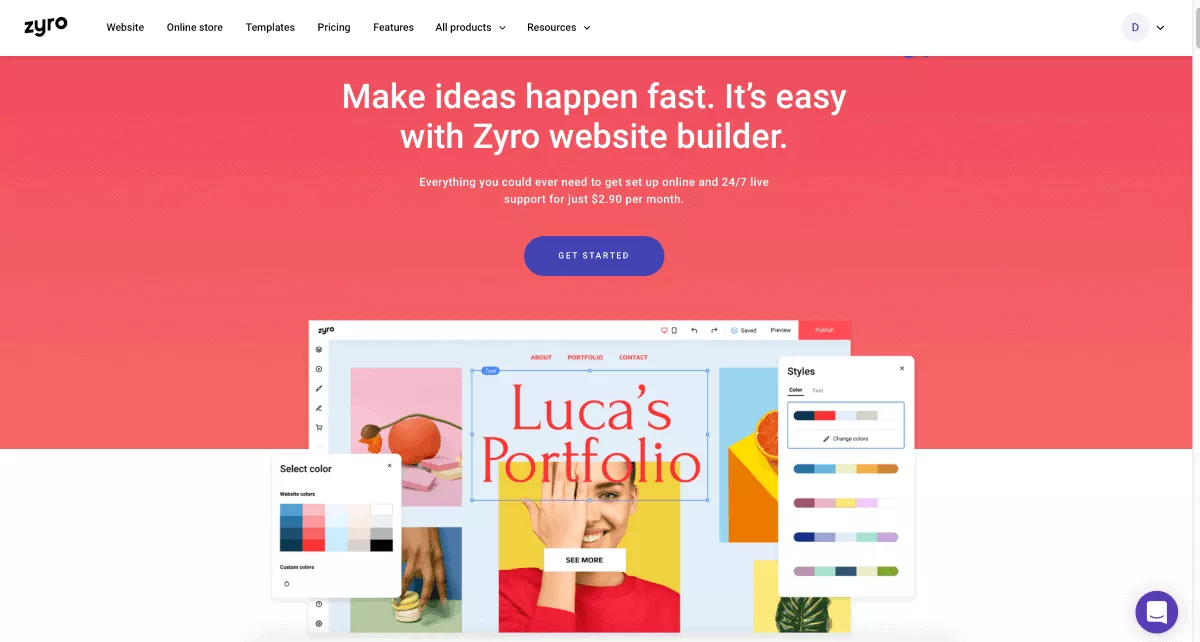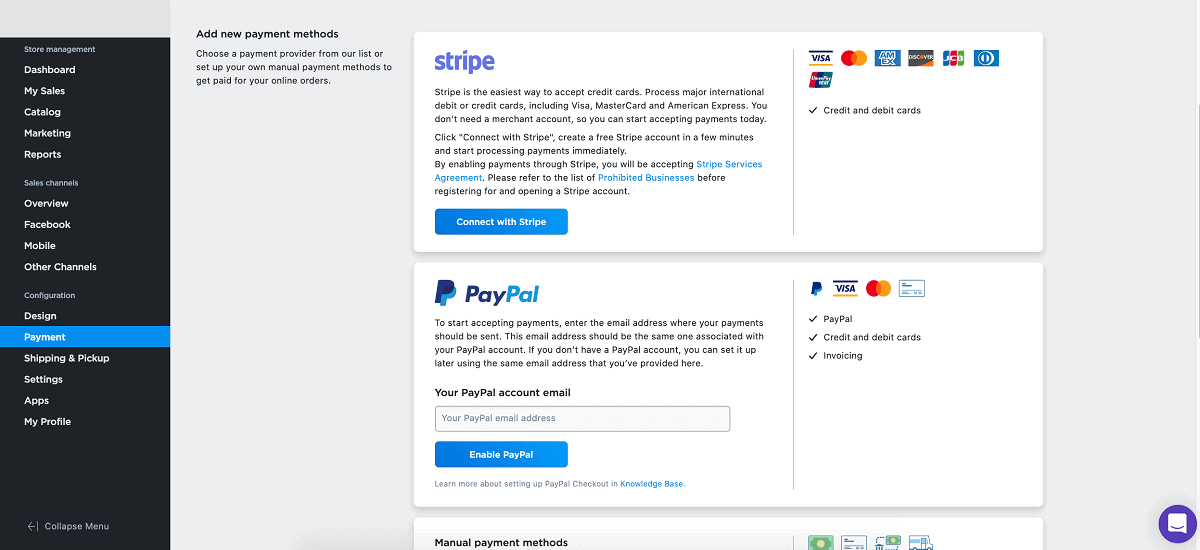Our in-depth step-by-step guide on how to get a wildly successful online business up and running!
So, you want to start an eCommerce business. I mean – why wouldn’t you?
The future of eCommerce is blindingly bright – expected to value more than $6 billion by 2024. And you already have all the tools you need: this internet connection right here!
This guide will walk you through the process of starting your very own eCommerce business.
How to Start Your Own eCommerce Business
More on Running an eCommerce Business
Wrapping Up
Gone are the days where business owners needed to rent retail space or retail staff. We live in an era where products can be browsed, ordered, and sold – all online!
So grab a hot drink, bookmark this page, and let’s get started.

Your first step is to pick a niche for your new business.
Most people never take that first step towards their eCommerce business because they can’t pick a ‘winning’ idea. But choosing a niche doesn’t need to be complicated.
A good place to start is by looking at what you’re already passionate about. Maybe you’re a coffee enthusiast, or love skincare or sneakers.
Love socks? Start an online boutique.
Fitness enthusiast? Sell your workout plans.
Even the most obscure hobbies can be monetized. I mean, there are YouTubers who sell their used bathwater. Opportunity is literally everywhere!
Alternatively, try and identify a gap in the market. Look for a growing industry, an audience that is underserved, or a frustration you can solve.
Next – brainstorm ideas for the actual key products you want to sell. Start with the obvious questions: is it a product or a service? Physical or digital?
A very common eCommerce strategy is to identify ‘trending products’ with high demand. One of the easiest ways to spot trends is to search for your product on online marketplaces like Amazon and get inspiration from the suggested keywords and reviews. You’ll be amazed what you can learn this way.
Other ways of finding trending products include:
A word of warning against ‘trending’ products…
If you want your store to have some longevity, don’t build your entire business around a single fad that’s going to fizzle out in a month (remember when fidget spinners were a thing…?)
To prevent crashing and burning, make sure you validateyour product idea with some market-based criteria. Simply put, ask yourself these questions:


eCommerce businesses come in all different forms. From the entrepreneurs pushing millions of $$ from online courses, to the artists crafting products by hand.
Yup – it’s time to decide which eCommerce model you want to use. This will affect your logistics, as well as the initial start-up capital you’ll need. Here are some common forms of eCommerce:
You manufacture/assemble the product yourself, and send them directly to your customers.
You’re the middle man who sells to customers without stocking any physical product. When a customer makes an order, the manufacturer ships the product to them directly.
You source products from a partner and agree to sell them under your own brand name.
B2B model, you purchase from manufacturers/self-manufacture and sell in bulk to retailers.
You curate a product/set of products to be delivered at regular intervals to your customers
Selling products that only exist digitally – like selling stock photos, music, eBooks or online courses.
Look into the various models and make sure you’re clear on the entire process of how your product is sourced and delivered to your customers. Once you’ve chosen a model, it’s time to sit down and write up a business plan!
Business plans are fantastic. They help you fill in the blanks and start thinking through the grittier details of how you’ll run your business.
You can find lots of free business plan templates online (which you’ll need if you’re applying for a business loan) but they typically include:
In short, it’s a great problem-solving exercise.
Important Note
Pay special attention to your finances. Many new eCommerce business owners fail to think through their resource-use properly. Now’s the time to estimate your monthly expenses and revenue, choose invoicing software, and calculate key metrics like your break-even point.

It’s finally time to start bringing your business into the real world.
If you haven’t already, choose a suitable business name. If you’re based in the US – you can check its availability in the U.S. Patent and Trademark Office.
Most people will use their business name in their website domain name, so now’s a good time to check whether that’s available too. The best way is to use a free domain name generator.
Finally, go get your business logo. You can find a freelance designer on marketplaces like Fiverr, or just engage a graphics company like Looka.
Your business entity type will have important legal and financial implications. The most common types for eCommerce businesses are sole proprietorships, general partnerships, LLCs, and corporations.
Sole proprietorships are the simplest business type; if you don’t mind operating under your personal name, you won’t even need to file any formal paperwork! The downside is that you can be held personally liable for any business debts.
Filing for an LLC will give you some liability protection. OR if you plan to bring on investors, you may want to register as a corporation.
It’s not a decision to make lightly, so I strongly recommend you look into some official resources like the Small Business Administration website. Read around or speak to a legal professional to fully understand which entity is best for you.
Whatever entity you choose, it’s always best to keep your business and personal finances separate.
Consider opening a business bank account to receive payments, and setting up a business credit card to pay suppliers. If you’re based in the US, this may require you to apply for a 9-digit employer identification number (EIN) which can easily be done from the IRS’s official website.
Finally, it’s important to check if you need any additional licenses and permits. If you’re in the US, these can include:
Which you need will depend on factors such as your business entity, your industry and your geographic location.
In other words, you’ll need to do your homework here! A good place to start is by checking your state or local government website.

Unless you’re developing all your products from scratch, you’ll probably need to partner up with a supplier or manufacturer.
If you’re looking for local partners, you can hit up local markets, trade shows, merchandise marts, and networking events.
You can also look through manufacturing directories, or just Google manufacturers for your specific product. There are plenty of international marketplaces like Taobao or eBay who sell at wholesale prices. Remember:
It’s normal to take time to find the perfect partners. However, it’s always worth it!
A popular pricing strategy for new business owners is cost-plus pricing. We’ve explained it properly in our guide on how to price your products.
If you’re selling a physical product, make sure you take into consideration how you’re sending it to customers. Many people opt for the US Postal Service or solutions like UPS and FedEx, but there are also some shipping rate comparison services like ShipStation that can help you cop good rates.

Now, it’s time to sort out WHERE you’re selling your items.
Some eCommerce owners sell on popular marketplaces such as Amazon or Etsy. The downsides are that these platforms usually charge you a commission from any sales you make. Plus, you’re entirely at the mercy of their rules and algorithms.
If you want full creative control over your store, you’ll need to set up your own eCommerce website.
By far, the easiest way to build a website is with an eCommerce platform. These will serve as a virtual storefront for your customers, whilst giving you a back-end interface that makes it really damn simple to run your business.
Just remember – different platforms tick different boxes. If you decide to go with a free CMS (like WordPress) you’ll also need to purchase eCommerce hosting, and a domain name. Other eCommerce platforms are ‘all-in-one’ and will include all that for you.
At a glance – here are some of the most popular eCommerce platforms:

Zyro is as simple and easy-to-use as they get. They come with lots of prebuilt templates and AI tools to get your site up quickly. They also have a great dashboard that helps you manage everything: from inventory and order tracking, to sales tax and customer service. However, they have fewer fancy features than some website builders.
Read more: Our in-depth Zyro review.

WooCommerce is actually a WordPress plug-in, but it’s beautifully open-source, stuffed with eCommerce features, and totally free! The downside is that WooCommerce can be confusing for beginners, as it’s slightly more technical. You’ll need to purchase and connect your own web host and domain, separately.
Read more: Our step by step guide to setting up a WooCommerce store.

Shopify is one of the most famous eCommerce software. It’s all-in-one, which means you simply sign up for a plan, build your store, add features, and launch it. It’s a very powerful tool that’s perfect for fast-growing businesses, but comes at a higher cost.
Read more: How to start a Shopify store (5-part guide).

Once you’ve signed up for your eCommerce platform – the fun part begins! It’s time to build your website.
Most eCommerce platforms offer pre-built templates that you can pick from. Simply pick a theme you like and customize it to your liking. Remember, different colors affect emotions in different ways. Make sure your design and website color scheme fits your branding.
Most platforms also offer ‘coming soon’ templates which are perfect if you want to start getting traffic and sign-ups but aren’t quite ready to start selling your products. Check out these coming soon page examples for inspiration!
When building your main eCommerce website, you’ll probably need the following pages:
In order to allow customers to pay for products in their shopping carts, you’ll also need to configure your payment processor. Most eCommerce platforms will allow you to easily integrate a range of payment methods and shipping providers.

If you hate dealing with legal jargon…
Different websites will need different legal compliance according to where they’re based. Since privacy laws change at lightning-speed, the easiest way to cover your bases is to use a compliance service like Termly which can help generate disclaimers and T&Cs for you.
And when you’ve finished your website and are ready to sell?
Set up your transactional emails, test everything is working and then – hit launch!

Congratulations, new eCommerce site owner!
Now you’re now ready to bring in customers – it’s time to put your efforts into marketing your eCommerce website. Here are just a few ideas:
For more details, check our guide on how to market your product.
These days, it’s entirely possible to start a basic eCommerce business with less than $100 (paid towards your eCommerce subscription, licenses, and any third-party subscriptions).
Realistically however, this varies massively depending on your eCommerce model. You can easily spend thousands on warehousing space or inventory, or you can keep costs low by outsourcing some processes – e.g., by using a dropshipping model.
Here are some of the common costs of starting an eCommerce business:
A successful eCommerce website will need to meet certain customer expectations. Here are 3 characteristics that all the good ones have in common.
Customers won’t stay on a site that is slow or confusing to navigate. Make sure your eCommerce website loads quickly and is easy to navigate – no matter what device it’s being accessed on. If you’re not sure whether your site is fast enough – just paste the URL into our free website speed checker tool.
A great website layout and search bar can also help users find what they’re looking for, quickly.
Having a strong brand will help you connect to your customers and be more memorable to them. Make sure that your website design and messaging is cohesive, and tells a good story.
Your choice of words also matters when describing your products. Make sure you write compelling product descriptions that appeal to your reader’s emotions.
You should supplement this with high-quality photos that help your products shine. Check our guide on how to take great product photos, even on a budget.

If you want customers to be comfortable handing over their credit card information, you’ll need your site to look trustworthy and legitimate.
A great contact us page, positive customer reviews, and some sort of active social media presence will help customers feel like you guys are the real deal. And of course – make sure your website has an SSL certificate installed!
You now know all the steps you need to take to start up your own eCommerce business!
Let’s recap quickly the steps we’ve covered today:
As our last piece of advice for starting your eCommerce business is to stay nimble. Times change fast – and especially so on the internet. Keep optimizing your site, stay on top of trends, and keep on adapting!
We’d love to see what you come up with. Make sure to join our Telegram group of fellow freelancers and entrepreneurs, and drop us a line!